XX.
Chinese intervention in Tunquin, and the
 Nguyen Dynasty.
Nguyen Dynasty.
At the request of the wife and son of King CHIEU-THONG, who
was hiding himself in the Cao-bang mountains, the Emperor K'IEN-LUNG
ordered his armies to enter Annam and to re-establish the former
state of affairs, that is to say, to restore to the LE Dynasty
the entire territory of Tunquin of which they had been deprived
by the Tay-son rebels.
The Viceroy of the Liang Kuang provinces, SUN CHE-I,
was appointed commander-in-chief of the Chinese armies, and
assisted by General SHIU CHE-HENG, he entered Annam from
Kuang-si in November 1788 at the head of ten thousand Cantonese
soldiers. Another Chinese army commanded by General HU
TA-KING invaded Annam from Yunnan. They were joined by the
irregular Annamese troops who had remained faithful to the
fallen dynasty, and after several easy victories following each
other in rapid succession, the Chinese commander-in-chief
entered Ha-noi in Drcember of the same year and re-instated King
CHIEU-THONG on the throne.
A month afterwards, however, the rebel chief HUE entered Ha-noi
by stratagem, and having come upon the Chinese unawares,
completely routed them and forced the Viceroy and the Annamese
king to re-cross the frontier into China.
The court of Peking degraded the Viceroy SUN and gave the
supreme command of the army to FU KANG-NGAN, Viceroy of
the Yun-Kuei (Yunnan and Kuei-chao). The new coinmaiidef-in-chief
re-entered Annam without delay, concluded a truce with HUE, and
wrote a long report to the Emperor in support of the rebellion.
Thereupon K'IEN-LUNG issued the following edict, published in
the A Ta Tsing Vui-tien in 1789. "In consequence of a
revolution King LE CHIEU-TONG lost his royal seal and
became a fugitive. The Annamese then recognized as head of the
Government NGUYEN QUANG-BINH ( QUANG-TRUNG, Or HOE) who
now submits to our authority and craves permission to come to
Peking to gaze upon our august Majesty. The [provincial judge of
Kuang-si, TCH'ENG-LIN, is hereby commanded to invest him
with royal power in our name, and to bestow upon him a gilt
silver seal in the shape of a camel."
After the promulgation of this edict the Chinese armies were
ordered to retire from Annam, and thus closed the war.

No. 212. - Obverse:



 Can-long-thong-bao.
Can-long-thong-bao.
Reverse:

 An-nam. White Copper. Cast in Yunnan for the payment of the
Chinese troops.
An-nam. White Copper. Cast in Yunnan for the payment of the
Chinese troops.
The
 Nguyen Dynasty. From 1776 to the present time.
Nguyen Dynasty. From 1776 to the present time.
King

 GIA-LONG was the nephew of King DUE-TONG, THE last sovereign of
Cochinchina, and being gifted with an active mind and with great
powers of organization, he determined to reconquer the territory
which had been taken possession of by the Tay-son rebels.
GIA-LONG was the nephew of King DUE-TONG, THE last sovereign of
Cochinchina, and being gifted with an active mind and with great
powers of organization, he determined to reconquer the territory
which had been taken possession of by the Tay-son rebels.
His lack was at first a very changeable one, for at one time
he reigned in the South of Cochinchina with absolute power, and
at another he found himself alone, persecuted, without an army,
and forced to take refuge in Siam. At last success favoured him.
With the help of the French, secured through the direct
intervention of the Bishop of Adran, and assisted by the Siamese
and Cambodian armies, he not only re-occupied the former
territory of the Quang-nam Principality belonging to his family,
but also took possession of the whole of Tunquin. Out of these
conquests he formed the kingdom of Annam, and in 1801 proclaimed
himself king, thus founding the NGUYEN Dynasty, which is still
in power at the present day.
Since then four kings have ascended the throne. The history
of their reign contains but little worthy of note; moreover, it
is' still of too recent a date to be dealt with impartially.
These four kings are principally remarkable for their hatred
towards foreigners and for their persecution of the Christians.
It is only through the pressure of European armies that they
have consented to open several ports to foreign trade, and at
this very moment the country seems to be passing through a
crisis, menaced as it is by the intervention of the French in
Tunquin, who may possibly annex it in the same way as they
annexed Lower Cochinchina twenty-five years ago.

No. 213. - Obverse:



 Gia-long-thong-bao.
Gia-long-thong-bao.
Reverse: plain. Three kinds of cash, made of copper,
lead, or zinc.

No. 214. - Same as before, but of larger size. Copper
mixed with tin.

No. 215. - Obverse: Same as No.
213.
Reverse: without rim. Some are made of white copper,
others of dark red copper.

No. 216. - Obverse: Same as No.
213.
Reverse: A dot above the hole.
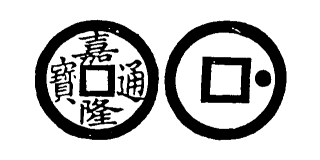
No. 217. - Obverse: Same as No.
213.
Reverse: A dot on the right of the hole.
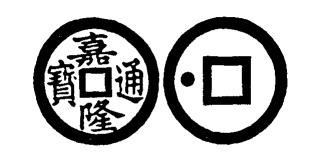
No. 218. - Obverse: Same as No.
213.
Reverse: A dot on the left of the hole.
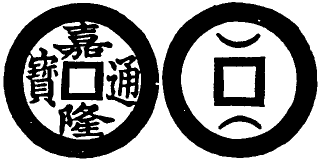
No. 219. - Obverse: Same as No.
213.
Reverse: Two crescents above and below the hole.

No. 220. - Obverse: Same as No.
213.
Reverse: Two crescents on the right and left of the hole.

No. 221. - Obverse: Same as No.
213.
Reverse: A dot and a crescent on the right of the hole.

No. 222. - Obverse: Same as No.
213.
Reverse: with a double rim.
All the above coins, from No. 216 to 222, are made of copper
mixed with tin.
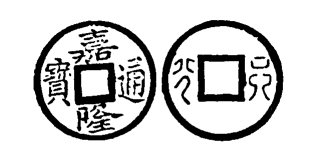
No. 223. - Obverse: Same as No.
213.
Reverse: The characters

 Luc-phan, or six phan, indicating the weiglit of the cash.
Luc-phan, or six phan, indicating the weiglit of the cash.

No. 223. - Obverse: Same as No.
213.
Reverse: The characters

 That-phan, meaning the weight of the cash. There exist three
different cash of this description, made of copper, lead and
zinc respectively.
That-phan, meaning the weight of the cash. There exist three
different cash of this description, made of copper, lead and
zinc respectively.

No. 225. - On the obverse and
reverse the inscription



 Gia-long-thong-bao.
Gia-long-thong-bao.

No. 226. - Same as before, but having the inscription
on the reverse upside down.
All the above cash, from No. 213 to 226, were issued by King
GIA-LONG (1801-1820). They were only made in Hue and Ha-noi.
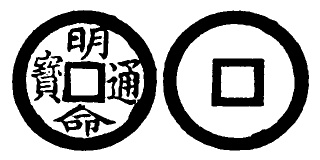
No. 227. - Obverse:



 Minh-mang-thong-bao.
Minh-mang-thong-bao.
Reverse: plain. White copper.

No. 228. - Same as before, but of smaller size Copper
and lead.
The two above coins were issued by King MINH-MANG
(1820-1838). The custom of casting medals with inscriptions on
the reverse, such as or was followed by this king;
but they never went into circulation.
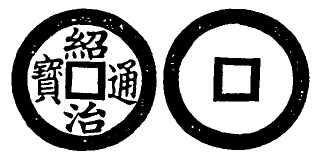
No. 229. - Obverse:



 Thieu-tri-thong-bao.
Thieu-tri-thong-bao.
Reverse: plain. White copper.
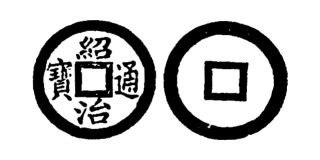
No. 230. - Same as before, but of smaller size.
Copper, zinc, and lead.
The above coins were issued by King THIEU-TRI (1838-1845).
The coins of the reigning king are as follow:
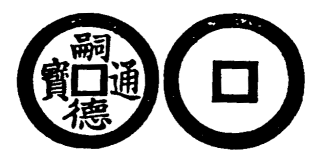
No. 231. - Obverse:



 Tu-duc-thong-bao.
Tu-duc-thong-bao.
Reverse: plain. Copper mixed with tin.

No. 232. - Same as before but of smaller size. Two
kinds, made of copper or lead.
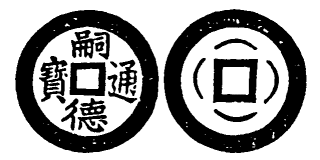
No. 233. - Obverse: Same as No. 231.
Reverse: Four crescents round the hole. Zinc.
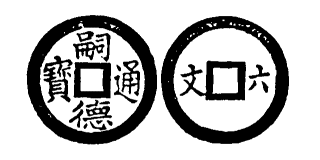
No. 234. - Obverse: Same as No.
231.
Reverse: The characters

 Luc-phan, indicating the weight of the coin. Copper mixed with
tin.
Luc-phan, indicating the weight of the coin. Copper mixed with
tin.

No. 235. - Obverse: Same as No.
231.
Reverse: The characters

 Ha-noi, where the cash was cast. Lead.
Ha-noi, where the cash was cast. Lead.
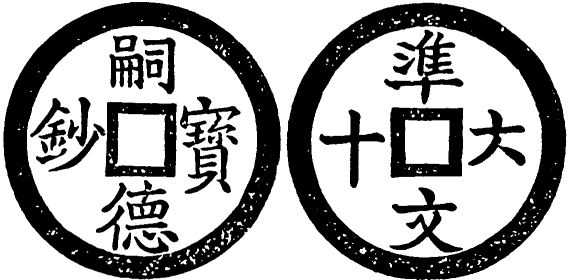
No. 236. - Obverse:



 Tu-duc-bao-sau.
Tu-duc-bao-sau.
Reverse: The characters



 Chun-van-luc-tap, or equal to sixty cash. These coins were first
issued in 1877 from Ha-noi, and the value of one tien was given
to them; but on account of their inferior intrinsic value the
people disliked them, and their circulation was in consequence
very limited.
Chun-van-luc-tap, or equal to sixty cash. These coins were first
issued in 1877 from Ha-noi, and the value of one tien was given
to them; but on account of their inferior intrinsic value the
people disliked them, and their circulation was in consequence
very limited.
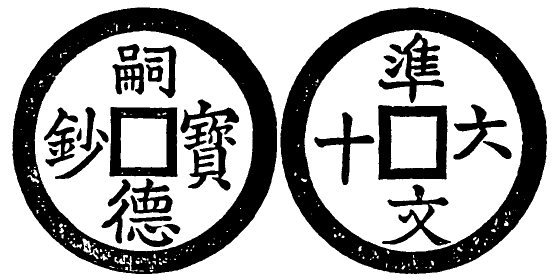
No. 237. - Same as before, but of smaller size.
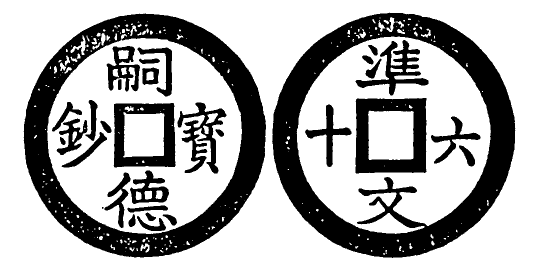
No. 238. - Same as before, but still smaller and
thinner.
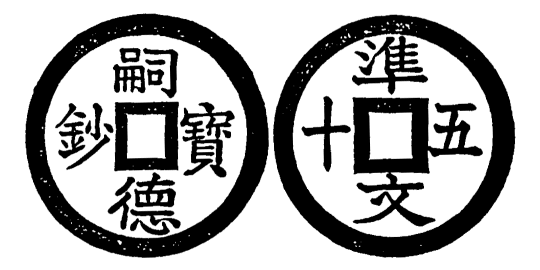
No. 239. - Obverse: Same as No.
236.
Reverse: The characters



 Chun-van-nghu-tap, or equal to fifty cash.
Chun-van-nghu-tap, or equal to fifty cash.
In order to bring these coins into general circulation the
Annamese Government reduced the value of the tien to fifty cash,
in 1878, and allowed them to be used for the payment of taxes.
http://www.e-cadao.com/tientevn/best-replica-audemars-piguet-royal-oak-offshore-rubens-barrichello-ii.html
http://www.e-cadao.com/tientevn/replica-audemars-piguet-jules-audemars-chronograph-25859st-watch.html
http://www.e-cadao.com/tientevn/replica-audemars-piguet-royal-oak-offshore-lady-chronograph-rose-gold-watch.html
|
